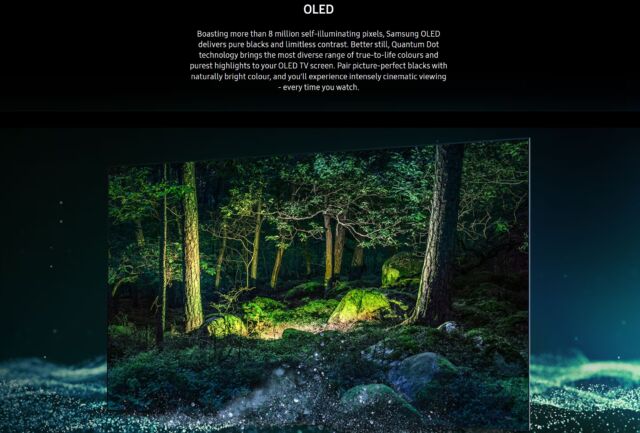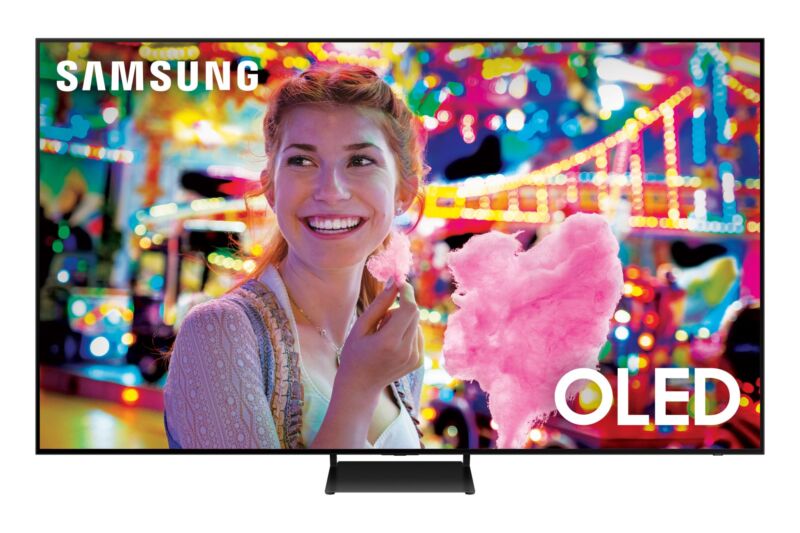Samsung rejuvenated the OLED TV market when its display manufacturing subsidiary, Samsung Display, announced QD-OLED two years ago. Quantum dot-infused OLED panels brought the promise of richer color compared to LG Display's white OLED panels (WOLED) and represented a viable competitor to what had become OLED TVs' only option. Various companies, from Samsung Electronics to Sony, bragged about the purported advantages QD-OLED brought over WOLED. Samsung is not so boastful these days.
Samsung's 2024 OLED TV lineup will feature TVs that use QD-OLED and WOLED panels. Samsung started doing this last year with the 83-inch S90C. But this year, it will reportedly be even harder to tell if a new Samsung OLED TV has quantum dots.
Samsung announced the entry-level S85D, the S90D, and the flagship S95D in January without specifying the type of OLED panel tech(s) involved. But it was still apparent that the S90D would include WOLED options since Samsung said it would come in 42-, 48-, 55-, 65-, 77-, and 83-inch sizes. QD-OLED doesn't come in 42, 48, or 83 inches.
But a report this week from Korean news outlet The Elec spotted by FlatPanelsHD said, per a Google translation, that the other S90D screen sizes may be WOLED or QD-OLED.
Vincent Teoh, the display expert behind the HDTVTest YouTube channel, in a video shared Saturday said:
Samsung won't explicitly advertise any of its 2024 OLEDs as QD-OLED.
Teoh added, though, that at a showcase Samsung recently held in Frankfurt, there was a 55-inch S90D on display that he confirmed was QD-OLED, "based on its subpixel configuration."
The Elec reported this week, per Google's translation, that Samsung's use of both WOLED and QD-OLED for its S90D TVs stems from LG Display requesting that Samsung not position WOLED as lesser than QD-OLED. Notably, though, it's expected that Samsung's most expensive 2024 OLED TV, the S95C, will use QD-OLED for all sizes.
Samsung was long resistant to selling OLED TVs, opting to sell LCD panels with quantum dots as its premium TV option instead. However, amid LCD manufacturing partners in China increasing prices, growing consumer interest in OLED, and reported pressure from the South Korean government, Samsung sought to get into OLED and eventually formed a partnership with rival LG.
The Elec also reported that Samsung is considering making its cheapest 2024 OLED TV, the S85D, only available with WOLED but that Samsung hasn't made a final decision. When checking out a unit on display at CES 2024, Teoh confirmed that that specific unit had WOLED.
Why it matters
Now that Samsung is pushing WOLED, it has muddied its original claims about OLED and quantum dots, opened the door for customer confusion, and made it even harder to differentiate between different OLED advancements.
If reports pan out, shoppers will have a harder time knowing what sort of subpixel arrangement a 2024 Samsung OLED TV has. As a refresher, WOLED panels have WRGB subpixel structures, while QD-OLED panels use a triangular RGB subpixel arrangement. Reviews have shown these discrepancies resulting in performance differences. QD-OLED TVs, for example, have purer colors, as RTINGS puts it, because there's "less noise between pure colors, as they're not diluted by the white subpixel." QD-OLED has also been shown to offer more full-screen luminance than older WOLED panel generations. However, the white subpixel in WOLED displays is advantageous when it comes to displaying white, which is especially important for things like highlights and HDR.
For display technologists, entertainment enthusiasts, cinephiles, and people particular about expensive purchases, those differences could be deciding factors when buying a TV.
Samsung adding more WOLEDs to its TV lineup could stoke more confusion for shoppers because the company won't bother telling people what they're getting. Many TV shoppers don't have access to demo units or rely on online retailers for TV purchases, and many don't know how to confirm a TV's subpixel layout, either.
Samsung's reported decision to put less emphasis on its OLED TVs' use of quantum dots also somewhat contradicts the OLED TV wars, which have been fun from a technology perspective and helpful for competition. More competition puts pressure on display makers to make better products with differentiating qualities.
When Samsung started getting into OLED TVs again, it promoted its use of quantum dots, something it long encouraged in TVs. But now, when it comes to actually selling OLED TVs with Samsung branding, Samsung's messaging falters.

A promotional image for Samsung's S95B, its first QD-OLED TV, bragging of quantum dots.
Samsung
When Samsung debuted its first QD-OLED TV, the S95B, some were surprised to see that it didn't incorporate "QD," "quantum dot" or something of that nature, into the naming. At the time, a Samsung rep told CNET: "Since the term OLED is already widely accepted and understood, Samsung decided to go with the nomenclature 'Samsung OLED TV' to avoid confusion among consumers."
But Samsung's tech didn't make OLED "widely accepted and understood" in TVs; rival LG did. In fact, Samsung spent years trying to convince people that its QLED TVs were favorable, especially when considering OLED burn-in.
Now that Samsung sells not just OLED, but also WOLED panels, it seems to be trying to muddy the waters between premium TVs with and without quantum dots. While other OEMs may continue to highlight whether their OLED TVs leverage quantum dots, Samsung is trying to force customers to make purchases without this information readily available. There's no word of this yet, but it's possible that one day, this strategy could trickle over into Samsung OLED monitors.
Reviewers, display experts, and tech companies have all touted the differences between WOLED and QD-OLED. By trying to ignore that, Samsung may end up befuddling customers and belittling some of the technical advances and debates that have made OLED exciting recently.



3175x175(CURRENT).thumb.jpg.b05acc060982b36f5891ba728e6d953c.jpg)

Recommended Comments
There are no comments to display.
Join the conversation
You can post now and register later. If you have an account, sign in now to post with your account.
Note: Your post will require moderator approval before it will be visible.